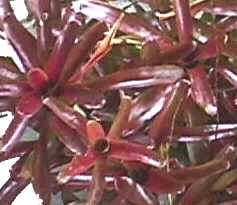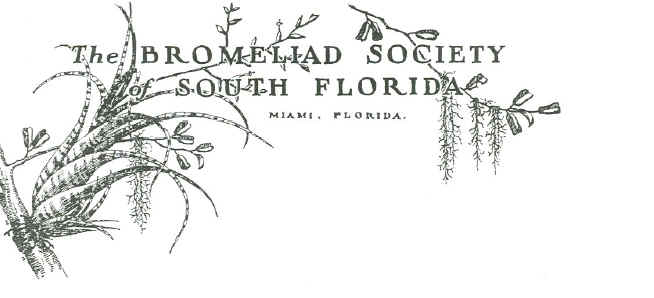SOLVING THE FIREBALL MYSTERY
By Nat DeLeon
1987 FCBS newsletter,
reprinted in February 1998 newsletter

Neoregelia 'Fireball'
In 1959, I wrote to a Mr. Walter Doering of Sao Vicente Brazil, in the state of
Sao Paulo.
Mr. Doering was primarily an orchid collector who had earlier written an article
on the bromeliads of his area for The Bromeliad Society Bulletin, the forerunner
of the Journal
of the Bromeliad Society.
During that time, I wrote to whoever I could
in the hope of being able to purchase or
trade for new bromeliads not already in cultivation. In this instance I was
primarily
interested in buying at least half-grown plants of Vriesea gigantea and Vriesea
hieroglyphica. He had several other species I was interested in as well. Once
Mr.
Doering had confirmed that he would sell me the plants, I inquired about the
possibility
of buying other species as well, even if he had only a few plants of each. He
replied
that yes, he did have others but they were unidentified. I then suggested that
all such un-identified plants be numbered so that we might have a common
reference point to
refer to on any specific plant in the future. I would grow the plants to
flowering, have
them identified and, should they prove ornamental enough, I would order
additional
plants by name and number. Mr. Doering was agreeable to this.
Correspondence was slow and Mr. Doering needed
time to collect and prepare the
plants for shipment. This was no small order. In March, 1960, almost a year
after my
initial inquiry, the plants arrived. There were more than 200 plants in the
shipment.
Losses were heavy, particularly of Vr. hieroglyphica. Only eight out of some
fifty
large plants survived. Losses of other species occurred also but were far less
severe.
This shipment proved to be very important, for
it represented the first bromeliad
introduction into American horticulture of the following species: Vr.
bituminosa, the
large form of Vr. incurvata then Vr. rostrum-aquilae, Vr. ensiformis, Vr.
flammea Vr. erythrodactylon, Vr. phillipo-coburgii, Vr. scalaris, Vr. vagans,
Nidularium rosulatum, Nid. rubens, Nid. rutilans, Neoregelia doeringiana, a new species to be named
Neo. maculata and our mystery plant, Neo. 'Fireball'.
Only one of the four plants, later to be
called Neo. 'Fireball' survived. As I remember
it, the smallish plant was almost all green, with a faint hint of red, when
received.
Mr. Doering remarked about the plant in the brief note he sent with the
unidentified
plants. "Neoregelia or Aechmea, small plant, all mahogany colored. Flowers
not yet seen." After the plant started to grow, exposed to the great Florida
light, the
mahogany color continued to intensify. Before long it sent out its first offset,
revealing
its stoloniferous habit.
The late Ralph Davis and I were rather close
bromeliad buddies. As long as either of
us had more than one of any given plant, his plants were my plants and vice
versa.
We lent one another plants for hybridizing or selfing. We also collaborated on
several importation ventures. Ralph visited me one day and almost swallowed his
cigar butt
when he first saw my mystery plant. Of course Ralph had to have one and since by
that time the plant already had two offsets, the first vegetative propagation
took place.
Since I was concerned about confusion in plant names even in those days I made
Ralph promise he would not part with any plants until it flowered and I could
have it identified.
Several years passed and our stocks of the
mystery plant were getting quite large but
there was still no sign of flowering. In the meantime, many people were starting
to
pester Ralph for a plant, which made it great 'trade bait'. I didn't have that
problem
since at that time I grew most of my bromeliads at the Parrot Jungle, away from
public
view. Ralph wanted to start letting some plants go and I agreed, provided we
gave the
plant a temporary name. Ralph told me that every time he referred to the plant
he called
Neo. 'Fireball' and I told him "That's a great name, let's call it
that." The rest is history.
During the latter part of 1966 I was getting
ready to treat some Neo. carolinae plants
with calcium carbide to induce flowering. Just for the hell of it, I decided to
treat a
single mature plant of 'Fireball' as well. In February of 1967, I saw my first
'Fireball'
flower ever. I had waited eight years to see this. By contrast, I had flowered
and had
identified all of the other unidentified plants in the importation group.
During those eight years I wrote to Mr.
Doering several times, hoping to be able to
order more 'Fireballs' and other species as well. I had also hoped to obtain
information
for Dr. Lyman Smith on collection sites for the various species being
identified, but I
never heard from Mr. Doering again.
My records show that on February 28, 1967 I
sent the first flowering 'Fireball' plant to
Dr. Smith for identification. It bore my number P.130. I have a letter of
confirmation
of that specimen, saying it needed further study, Years later, I have yet to
receive any
word of its status. I was told by several people that the National Herbarium
does not
have a specimen of 'Fireball'. I can only assume it somehow got misplaced or
perhaps
included in the file of some other neoregelia.
During the last decade or so, Neo. 'Fireball'
has been a point of much confusion. It
has been assumed to be a hybrid. This is understandable as many people in
horticulture assume a plant is a hybrid if it does not have a latinized name.
Yet there is nothing wrong with giving an unidentified species a temporary cultivar name. I have
sometimes
used the name of the town or area a plant was collected from as a reference
point. One
of the plants from this collection I called Nid. saopaulo. It was later
identified as Nid.
rutilans. Yet I still see plants around labeled Nid. Sao Paulo and it is usually
referred
to as a hybrid, which it is not.
Bob Wilson also used this method of
identification. Plants he sold as Neo. Tingua
were later identified as Neo. carolinae. Plants he sold as Aechmea Tingua turned
out
to be Ae. lingulata. The name Tingua referred to the town in Brazil near which
he
collected the plants.
A few years ago, the name Neo. schultziana was
being applied to 'Fireball'. How
this started I don't know. The name is not listed in Dr. Smith's monograph.
While I am still hopeful that Neo. 'Fireball'
w matter. After 26* years, it would be difficult to refer to Neo.
'Fireball'
by any other name.Ed. It is now 38 years and the mystery
remains.
|
